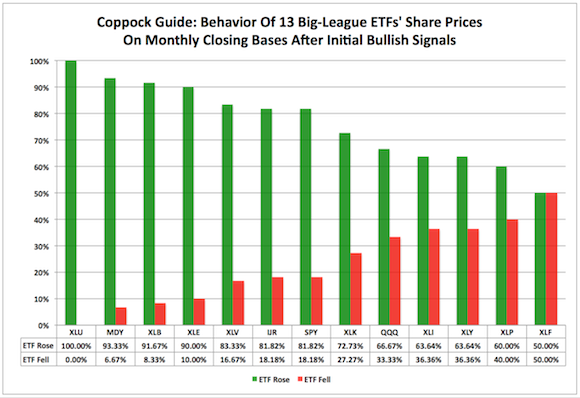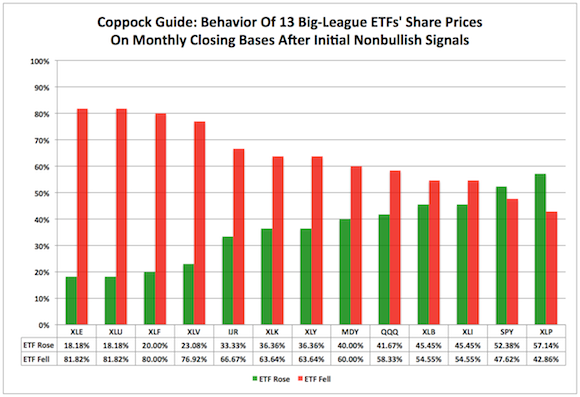The Coppock guide is among my favorite long-term indicators of
price movements in major equity-market indexes, which accounts for the recent J.J.’s Risky
Business series of blog posts centered on the guide’s past relationship
and present status in association with each of 13 big-league exchange-traded
funds.
Edwin S. Coppock introduced his guide, aka either the
Coppock curve or the Coppock indicator, in Barron’s
more than half a century ago. He designed it not to flash both bullish and
bearish signals but to generate only bullish signals. However, I employ it to
produce either bullish or nonbullish signals.
It is extremely important to keep in mind that a nonbullish
signal is not equivalent to a bearish
signal in the context of the Coppock guide as I use it. I anticipate a given
index and its derivatives may rise after a bullish signal and expect it might
do anything following a nonbullish signal (i.e., trade higher, lower or
sideways).
Accordingly, I couple my employment of the Coppock guide
with the use of another of my favorite long-term indicators of price movements
in major stock-market indexes, namely, the comparison of a given index’s most
recent monthly closing price with its 10-month simple moving average.
As is widely known, this market-timing model is the
centerpiece of Mebane Faber’s “A Quantitative
Approach To Tactical Asset Allocation.” I will be blogging about my
adaptation of this model in relation to each of the 13 ETFs mentioned in my
Coppock guide series of blog posts as we get closer to the overall market’s
inflection point.
Meanwhile, I have here for each of the 13 ETFs in the
Coppock guide series its current signal (i.e., either bullish or nonbullish)
and a link to the relevant blog post about it. These data are followed by a
couple of charts displaying the historical performance records of the Coppock guide’s
signals with respect to these ETFs.
Utilities Select Sector SPDR Fund
Energy Select Sector SPDR Fund
Health Care Select Sector SPDR Fund
Materials Select Sector SPDR Fund
Consumer Staples Select Sector SPDR Fund
Technology Select Sector SPDR Fund
Industrial Select Sector SPDR Fund
Financial Select Sector SPDR Fund
Consumer Discretionary Select Sector SPDR Fund
IShares Core S&P Small-Cap ETF
SPDR S&P MidCap 400 ETF
SPDR S&P 500 ETF
PowerShares QQQ
Figure 1: ETF
Behavior After Coppock Guide’s Bullish Signals
Source: This J.J.’s
Risky Business chart is based on
proprietary analyses of Yahoo Finance adjusted monthly share-price data.
Measured by their Coppock guide initial bullish signals
since inception, XLU has been hot, while XLF has been not. In predicting future
upward movements in share prices on monthly closing bases, the initial bullish
signals for the former ETF have been absolutely perfect and the signals for the
latter ETF have been absolutely imperfect.
Figure 2: ETF
Behavior After Coppock Guide’s Nonbullish Signals
Source: This J.J.’s
Risky Business chart is based on
proprietary analyses of Yahoo Finance adjusted monthly share-price data.
Again, it is extremely important to keep in mind that a
nonbullish signal is not equivalent
to a bearish signal in the context of the Coppock guide as I employ it.
Nonetheless, the Coppock guide initial nonbullish signals for XLE, XLU and XLF
collectively have compiled pretty interesting historical performance records
since inception.
Because the Coppock guide is calculated on the basis of
monthly data, I will be recrunching all the relevant numbers following the
market close on Friday.
Correction: This
recrunching of the relevant numbers allowed me to detect a data-download error associated
with MDY, which in turn enabled changes in this article’s graphics and their
related text: See SPDR S&P MidCap 400 ETF
(MDY) Coppock Guide: Nonbullish as of May Day 2014.
Related Reading
Author’s Note: This blog entry
is being cross-posted at both J.J.’s Risky Business and J.J. McGrath’s Instablog on Seeking
Alpha.
Disclaimer: The opinions
expressed herein by the author do not constitute an investment recommendation,
and they are unsuitable for employment in the making of investment decisions.
The opinions expressed herein address only certain aspects of potential
investment in any securities and cannot substitute for comprehensive investment
analysis. The opinions expressed herein are based on an incomplete set of
information, illustrative in nature, and limited in scope. In addition, the
opinions expressed herein reflect the author’s best judgment as of the date of
publication, and they are subject to change without notice.


No comments:
Post a Comment